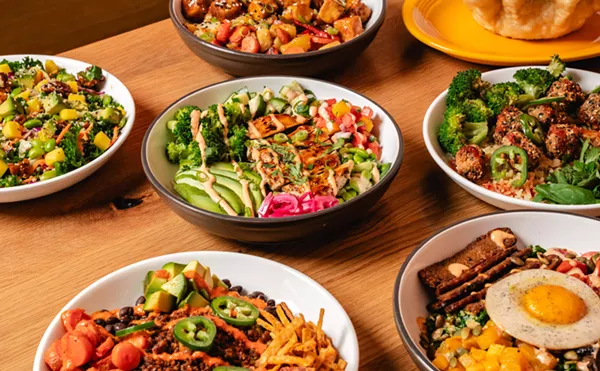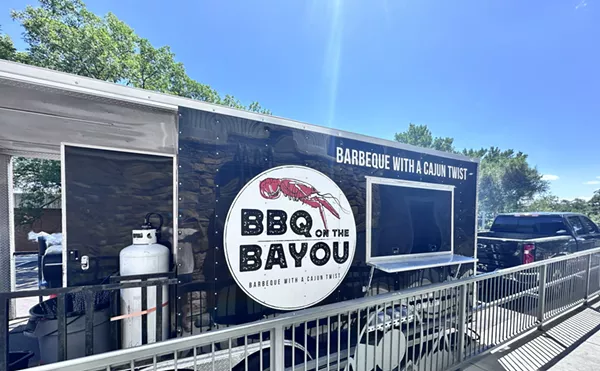The group in the car knew me well, but on that particular night, I had a hard time swapping stories and laughing along. I was distracted, pondering what I'd find when we finally got to Azitra, an Indian restaurant that opened near FlatIron Crossing in 2011. According to the website, the focus is on "classic Indian cuisine reinvented for today's more discerning palate." But what, exactly, does that mean?
Would I find curries stripped of cream sauces? Salads with tandoori-grilled chicken and a spritz of cumin-cardamom dressing? Deconstructed samosas, with puff pastry on one side of the plate and dots of chutney on the other?
See also: Scenes from the kitchen at Azitra
What worried me most was the possibility that reinvention was a code word for fusion, because we all know how well that tends to work out. Chefs borrow just enough of one cuisine to make you remember how much you like it, then veer in a different direction; it's the culinary version of sending a postcard when what you want is a long letter. If you've spent enough time with Indian food — if you've ground tiny balls of coriander until their woody shells crack and a lemony scent fills the air, if you've heard the sizzle of ginger and chiles hitting hot oil and breathed in the fragrant, heady warmth — you'll understand why a postcard, even a clever one, could never take the place of the real thing.
Fortunately, a long letter is just what Ashok Arora, founder-owner of Azitra and three other brands of Indian restaurants clustered mostly in Virginia, delivers. The predominantly Northern Indian menu includes both dishes you've heard of and many you haven't, with scattered Southern Indian touches like coconut, curry leaves and peppercorns, though regrettably none of the crepes called dosas that are common in the south. Certain preparations have been lightened, but there's still enough cream that korma seems like itself, not a skinny, Photoshopped replica. Dough is brushed with ghee (clarified butter), then folded and flattened into paratha. And despite a small section of "contemporary" entrees, such as garlic-rubbed rack of lamb and shrimp in saffron-ginger marinade, the menu contains plenty of old standbys, which is welcome news for sentimental types who fell for chicken tikka masala or biryani long ago and stand by their dish.
Deconstruction was nowhere in sight on our plate of samosas, with crisp shells that broke into shards over smooth, mildly spiced potatoes and yellow lentils. Nor was anything other than taste driving an appetizer called kaali mirch ka murg: moist chunks of peppery chicken slightly smoky from a stint in the tandoor (clay oven). A samosa did come out over chickpeas, with raw onions, tomatoes and cilantro on top, but far from being a sign of culinary playfulness, the dish was classic Indian street food, listed as the "chaat of the day."
By the time our main courses arrived, with bowl after bowl of lamb, chicken and paneer (cheese) in a sunset of orange, pink and yellow sauces, all paler than possible from so much cream, sour cream and yogurt, it was abundantly clear that tradition, not fusion or deconstruction, was the rule here. The chicken tikka masala had ample pieces of ginger-marinated white meat, as well as enough cream to soften the tomatoes' acidity. Chicken hariyali lazzatdar tempted with turmeric, coriander and cumin in a soft yellow gravy thickened with cream and cashew paste. Lamb rogan josh proved richest of all: The Creamsicle-colored sauce was so thick and pillowy, it was hard to believe that it was made of yogurt, not heavy cream whipped into soft peaks.
To cut the richness, you might look for a vegetarian dish. Palak paneer won't do the trick, though, since this version of creamed spinach with housemade triangles of paneer is just as lush. (Don't write it off entirely; just pair it with something lighter, perhaps that kaali mirch ka murg.) You could instead opt for the dairy-free eggplant bhartha. Eggplant can be oily or bitter, so many people shun it from bad memories — but try it anyway. A stint in the tandoor imparts smokiness, and sautéed garlic, onions and tomatoes deepen the flavors. (Hint: Eggplant bhartha handles spice well, so don't be afraid to ramp up the heat.) Chana masala also pairs well with fat-laden fare. This saucy chickpea dish has an abundance of spices — including some you've never heard of, like tangy amchoor (dried mango powder) — and more than lives up to its name, since masala means "spices." Order a selection of breads, perhaps the methi (fenugreek)-filled paratha or crackly, whole wheat roti, to scoop up the sauce when the legumes are gone.
As traditional as much of the menu is, experimentation is also going on, with varying degrees of success. Samosas are accented with Craisins, an inauthentic but cohesive choice. Gobhi Manchurian — a dish improvised by chef Mangal Singh, a longtime veteran of Arora's restaurants — has surfaced as a popular appetizer, with battered cauliflower in a barbecue-like glaze (could there be ketchup amid all that chutney and soy sauce?). Less successful is lamb patia, a sticky Azitra brainchild that recalls sweet-and-sour pork — orange, not red, from mango chutney. Tulsi-marinated salmon, a contemporary listing, also failed to impress, with inch-wide fillets coated with something I wouldn't have placed as basil had it not been for the menu's translation, and a side of tikka masala sauce that should have been coconut cream.
In terms of reinventing, Azitra has better luck with its fresh take on decor, with earth-toned booths and banquettes, walls accented with orange and green, and nary a red fabric lantern in sight. The space feels sleek and contemporary, though at times it can feel too quiet, perhaps because all the people out for dinner and a movie are busy trying to think of something to say. I wish Azitra's freshness had carried over to other things, perhaps a menu broken down into Southern and Northern fare, rather than "contemporary" and "traditional," to better showcase regional differences in this country of 1.2 billion. Why not adopt the small-plates trend and offer a nibble of eggplant bhartha, a bite of dal, a taste of tikka masala? With so many fragrant dishes to try, it would be nice to be liberated from the tired appetizer-entree formula.
At Azitra, it turns out that reinvention has less to do with cutting-edge culinary philosophy than decor and the conspicuous absence of a lunch buffet. But I'm not complaining. Because the samosas, breads and other traditional dishes are recognizable for what they are: delicious.











